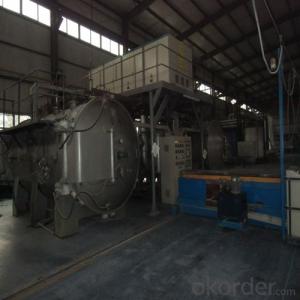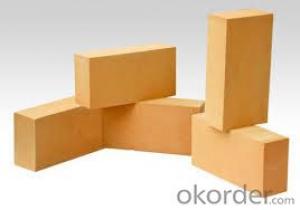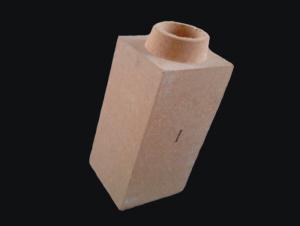Fireclay Brick SK34
- Loading Port:
- China Main Port
- Payment Terms:
- TT OR LC
- Min Order Qty:
- -
- Supply Capability:
- 500000 pair/month
OKorder Service Pledge
OKorder Financial Service
You Might Also Like
General Information of Fireclay brick
Our corporation producesa comprehensive range of Fireclay bricks, with 30% to 55% alumina content, allof these bricks exhibit excellent performance.
Our Fireclaybricks are the final result of blending excellent fused alumina and silicon asthe main raw materials with cutting-edge technology, adding superfine powder,after mixing, drying, forming, in the high temperature shuttle kiln. We ensureyou that the Fireclay Bricks made by us possess high quality standard and havegone through all the complicated quality control parameters. Their durabilityand strength adds life to the structure and they have the capacity of bearinghigh temperature.
Feature of Fireclay Brick
Resistant tothermal shock, abrasion, chemical attack
High ability foranti-abrasion during work
Low shrinkagedegree under high temperature so as to maintaining integrity of the furnacelining
Low apparentporosity, and low Fe2O3 content to reduce the carbondeposit in the blowhole and avoid the bricks broken in case of expansion
Applications of Fireclay Brick
Fireclay brick is mainlyused in the part of throat, stack, hearth, bottom for blast furnace and thestack for a big blast furnace.
1. Carbon bakedfurnaces in the alumina industry
2. Preheat zonesand cyclones of rotary cement kilns
3. Insulation forglass tanks
4. Coke ovens
5. Blast furnaces
6. Reheatingfurnaces
7. Suspended roofs
8. Lime kilns
9. Chimney
Technical Data of Fireclay Brick SK34 | ||
Physical Properties: |
|
|
Refractoriness | ℃ | 1750 |
Permanent Linear Change(1400℃×3h)% | % | ±0.2 |
Apparent Porosity, % | % | ≤19 |
Cold Crushing Strength | Mpa | ≥40 |
Refractoriness Under Load (0.2Mpa) | ℃ | ≥1400 |
Thermal Expansion at 1000℃, | % | 0.6 |
Density | g/cm3 | - |
Chemical Analysis: |
|
|
Al2O3 | % | ≥40 |
Fe2O3 | % | ≤1.8 |
Note: | ||
- Q: How to built refractory bricks as fitting between square and circle ducts
- Use rectangle at the bottom and knife type for the top. trapezoid for junction.
- Q: Are sintered brick concrete bricks?
- Many kinds of brick, according to the raw materials used for clay brick, shale, coal gangue brick, fly ash brick, lime sand bricks and slag brick;According to the production process can be divided into sintered brick and non fired brick, in which non fired brick can be divided into compressed brick, steam brick and autoclaved brick;With or without holes, ordinary bricks, porous bricks and hollow bricks can be divided into ordinary bricks.
- Q: Why should the clay bricks be watered first when they are building masonry walls?
- Sintered clay brick because there are a lot of capillary, in the dry state water absorption ability is very strong, if you don't use water, water in the mortar will soon be sucked out of the brick, mortar workability is reduced, operation is difficult to spread the real tile.
- Q: do the used refractory bricks pollute the environment?
- the main pollution of refractory brick is coal gas pollution in the process of burning , it can be recycled to produce aggregate, waste brick has no pollution.
- Q: should clay or refractory cement be used to lay refractory bricks?
- structure strength of this brick lining is not good, apply some refractory mud, only use some virgin clay and corundum, many of the traditional approaches are very simple, mullite and carbon slurry, the specific products are selected according to the selected material and water glass or organic binder. binding agent can choose phosphate, silica and high alumina, clay is one part of the refractory clay, there are many kinds of refractory slurry according to the material, clay-based mud does use refractory cement and corrosion resistance is low
- Q: What's the price of clay bricks?
- Clay brick in the fast price of 2.4 yuan or so, the price of 650-800 yuan per ton. Mainly depends on the amount of aluminum. Clay brick consists of heavy clay brick and light clay brick.
- Q: the amount of per square refractory brick of Various specifications and thickness of the refractory brick wall
- 9 grams-47. 7 grams- 47 calculate by your own according to the actual volume; cubic centimeter; 2.2 grams Clay brick 2: 1; 3, high alumina brick 3; cubic centimeter; standard density, cubic centimeter: 230mm * 114mm * 65mm, diatomite insulation brick 0, you can calculate the reference value
- Q: What kind of refractory material is used in the furnace when the boiler reaches more than 1200 degrees?
- except refractory brick, refractories include refractory concrete (refractory cement+aggregate), fire-resistant insulating layer (refractory cement+vermiculite powder or refractory cement + diatomaceous earth) and so on.
- Q: Do slag bricks have clay bricks strong enough?
- Clay bricks you mean should be red bricks burned out of the fire.
- Q: How to use the winding packaging machine to pack refractory bricks
- Over 150KG the most common winding machine can pack, if it is light or the goods scatter, then add capping or pre-drawn device is all right.
Send your message to us
Fireclay Brick SK34
- Loading Port:
- China Main Port
- Payment Terms:
- TT OR LC
- Min Order Qty:
- -
- Supply Capability:
- 500000 pair/month
OKorder Service Pledge
OKorder Financial Service
Similar products
Hot products
Hot Searches
Related keywords






























